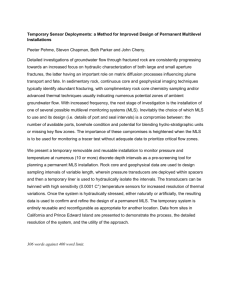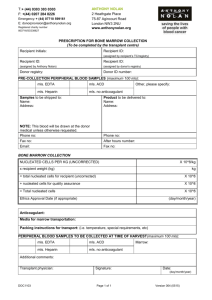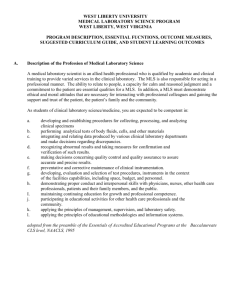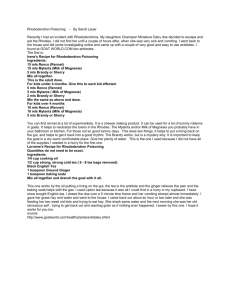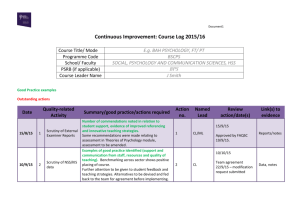3. co-existence with microwave landing system
advertisement
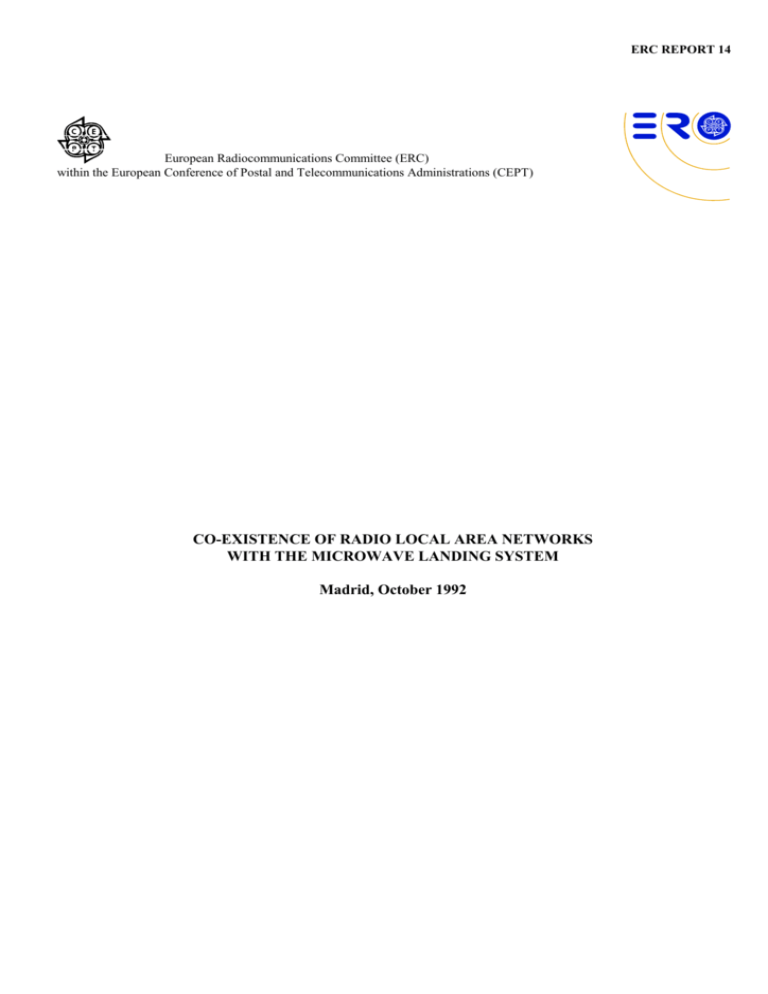
ERC REPORT 14 European Radiocommunications Committee (ERC) within the European Conference of Postal and Telecommunications Administrations (CEPT) CO-EXISTENCE OF RADIO LOCAL AREA NETWORKS WITH THE MICROWAVE LANDING SYSTEM Madrid, October 1992 Copyright 1992 the European Conference of Postal and Telecommunications Administrations (CEPT) ERC REPORT 14 Page 1 CO-EXISTENCE OF RADIO LOCAL AREA NETWORKS WITH THE MICROWAVE LANDING SYSTEM 1. INTRODUCTlON The aim of this study, based on earlier work at a UK university [1], was to investigate the co-existence of radio Local Area Networks (LANs) with the Microwave Landing System (MLS) in the band 5.00 GHz5.25 GHz. This report presents a general methodology which is used throughout in the calculation of interference levels for various scenarios. Interference from the radio LAN to the MLS only is considered. Based on the calculations radio LAN exclusion zones around MLS equipment are defined. Interference reduction using spread spectrum techniques is discussed. Finally, conclusions and suggestions for further work are presented. 2. GENERAL METHODOLOGY 2.1 Radio LAN Parameters A set of radio LAN parameters were proposed in a co-existence study for the 5.25 GHz-5.85 GHz band carried out by the UK Radiocommunications Agency [2]. These parameters were based on the Digital European Cordless Telecommunications (DECT) system which has many similarities to a radio LAN system in radio aspects and operating environment. The radio LAN parameters used in this study are based on these and are given in Table 1. These parameters are for a narrow-band system; no spectrum spreading is assumed at this point. PARAMETER VALUE Maximum EIRP 30 dBm Bit Rate 15 Mbits-¹ Bandwidth 20 MHz Required C/I 20 dB Maximum Tolerable Interference -13 l dBW/20 MHz Receiver Threshold -81 dBm Antenna Gain 2 dBi Table 1. Radio LAN Parameters The radio LAN maximum Equivalent Isotropic Radiated Power (EIRP) is scaled from that for DECT [3], which is 24 dBm in a 1.7 MHz bandwidth, according to the higher transmission loss at the higher frequency, the increased bandwidth and the reduced coverage. This gives a maximum EIRP of 30 dBm. The radio LAN bandwidth is scaled from that for DECT, which is 1.7 MHz for a bit rate of 1.2 Mbits-¹, according to the increase in bit rate to 15 Mbits-¹. This gives a bandwidth of 20 MHz. The radio LAN maximum tolerable interference is simply the thermal noise power in the equivalent noise bandwidth of the radio LAN The required C/I is an approximate figure, yet to be confirmed by ETSI. The receiver threshold is calculated from the required C/I and the maximum tolerable interference. The radio LAN antenna gain is 2 dBi, which is reasonable for a simple antenna, omni-directional in a horizontal plane (half wave dipole). However, radio LANs may use directional antennas to reduce time dispersion of signals by attenuating reflected components. In this case a maximum antenna gain can be calculated based on the maximum aperture available on a portable computer. The wavelength , at 5 GHz, is approximately 6 cm and hence the maximum aperture diameter is around 12 cm or 2 . The maximum directive gain for an aperture diameter, expressed in wavelengths D, is G = 10 log (2 D2) (1) This gives a maximum directive gain of 16 dB and assuming 40% efficiency a maximum overall gain of 12 dB. However, regulatory conditions will probably impose a maximum EIRP of 0 dBW (30 dBm). ERC REPORT 14 Page 2 The following further parameters given in Table 2 have been assumed for the out-of-band emissions of a radio LAN system and were obtained from the DECT ETS [2]. For DECT, the peak power level of any RF emissions outside the designated radio frequency band should not exceed 1 W (-60 dBW) at frequencies above 1 GHz in the measurement bandwidths and frequency offsets given in Table 2. It is assumed that similar limits could be applied in the future radio LAN standard. FREQUENCY OFFSET f FROM MEASUREMENT BANDWIDTH BAND EDGE Spurious Emission limit = 1W 0 MHzf° < 2MHz 30 kHz 2 MHzf° < 5 MHz 30 kHz 5 MHz f° < 10 MHz 100 kHz 10 MHzf° < 20MHz 300 kHz 20 MHz f° < 30 MHz 1 MHz 30 MHz f° < 12.75 GHz 3 MHz Table 2. Out-of-Band Emissions of Radio LAN 2.2 Interference Calculation All the following interference calculations are based on establishing a Minimum Coupling Loss (MCL) which is defined as the minimum power loss between the system and its interferer for maximum tolerable interference level . MCL = Pi + 10 log (BWs) - Is (2) BW i Pi is the interferer signal power, BWs and BWi are the respective bandwidths of the system (noise bandwidth) and the interfering signal and Is is the maximum tolerable interference level . The second term in the expression accounts for the interferer power falling in the system bandwidth. If the bandwidth ratio is greater than unity and all the interferer power falls in the system bandwidth this terms is zero. It is assumed that the interferer can be treated as band-limited white noise. However, a thorough investigation of interference effects requires integration of the total interference but this requires accurate knowledge of the interferer signal spectrum and system frequency selectivity (rejection) both of which are difficult to obtain for the existing systems and are un-available for radio LANs. Hence, the MCL must suffice. If a number of interferers in a particular location are considered then the interferer signal powers must be added and the MCL increased according to the increased interferer power. For example, if there are 10 interferers then the MCL would be increased by l0 dB. The MCL is achieved by adequate geographical separation of the two systems considered. The Transmission Loss (TL) must be greater than the MCL to ensure sufficient attenuation of signals from the interferer to the system. The TL in dB is TL = 20 logf + 10 nlogd - K - Gt - Gr + A (3) where f is frequency in Hz, n is the decay index (2 for free space, 4 for close-to-ground propagation), d is distance in m, Gt and Gr are the transmit and receive antenna gains and A is any additional loss such as building penetration losses, K is a grouping of fundamental constants given by: C_ K = 20 log ( 4 ) (4) The derivation of this equation is given in [4]. The TL is used in the following calculations to calculate a minimum separation distance of the system and its interferer and this distance can be used to specify the radius of an interferer exclusion zone around the system. The typical values for n and A used in the following calculations are based on measured values for buildings [5]. These were used in the absence of any measured values for aircraft. It is thought that propagation in aircraft will not be too dissimilar to propagation in buildings. ERC REPORT 14 Page 3 3. CO-EXISTENCE WITH MICROWAVE LANDING SYSTEM 3.1 Introduction to Problem The MLS system currently uses the band 5.00 GHz-5.15 GHz although the entire band 5.00 GHz-5.25 GHz has been reserved for this system. Radio LAN systems may be given spectral allocation in the band 5.15 GHz 5.25 GHz if it can be shown that the operation of radio LAN systems in this band will not adversely affect the MLS system. The MLS system may in the future expand into its entire allocated bandwidth. Hence, two scenarios must be investigated. l ) MLS and radio LANs co-existing in the same band 2) MLS and radio LANs co-existing in adjacent bands 3.2 The MLS System The MLS system is an aircraft navigational/guidance system for angle and distance measurement. Signals are transmitted from antennas on the ground and received by antennas on the aircraft. All received signals are interpreted in the MLS equipment on the aircraft. MLS system parameters are given in Table 3. These parameters were extracted from [6] and [7]. PARAMETER VALUE Bandwidth 150 kHz Thermal Noise Power -123 dBm (150 kHz) Maximum Tolerable Interference -120 dBm (150 kHz) Co-Channel Tolerable C/I>25.0 dB Adj-Channel Tolerable C/l > -20.5 dB ( l st) C/I >-25.0 dB (2nd) Minimum Signal Strength -95 dBm Antenna Gain 0 dBi System Frequency Selectivity (Rejection) 40 dB (5.092 GHz-5.250 GHz) > 75 dB (> 5.250 GHz) Table 3. MLS Parameters 3.3 Interference Scenarios MLS systems operate at higher power levels for greater coverage than radio LAN systems and hence interference problems should only occur in a near-far scenario when a radio LAN transmitter is close to an MLS receiver. There are two possible near-far scenarios: 1) Where a radio LAN on an aircraft is close to the aircraft MLS receiver. 2) Where many radio LANs are in a multistorey building close to the aircraft approach path to the airport and hence close to the aircraft MLS receiver. Scenario (1) is the more likely scenario if radio LANs or portable computers with radio LAN cards are used by passengers on aircraft. However, the use of radio LAN systems on aircraft could be prohibited avoiding this scenario completely. In this scenario the maximum signal from the radio LAN transmitter to the MLS receiver could be either through propagation out of the aircraft and to the MLS via its antenna or through propagation along the body of the aircraft and to the MLS via its casing. The former should be easier to estimate as it simply involves a penetration loss and path loss. The latter requires detailed information about the Electromagnetic Compatibility (EMC) specifications of the MLS equipment and casing. In either case the transmission loss is likely to be similar involving a similar distance and a similar additional loss. Scenario (2) is the less likely scenario because multistorey buildings are not built close to aircraft approach paths to airports for safety reasons. Such buildings are typically 1 km from the approach path. Also, at such distances the MLS signal strength at the aircraft will be much greater than the minimum signal strength given in Table 3 which is calculated for the limit of the MLS coverage volume. At this ERC REPORT 14 Page 4 limit of the MLS coverage volume the aircraft will be at a high altitude and any signals from radio LANs in buildings should be sufficiently attenuated by the large path loss. To investigate whether there is a potential interference problem in either of the above scenarios we must determine a radio LAN transmitter exclusion zone radius around an MLS receiver. The MCL and consequently the minimum separation distance are evaluated for MLS and radio LANs co-existing in the same and adjacent bands in the following sections. 3.4 MLS and Radio LANs in the Same Band The MCL for this scenario, based on the figures given in Table 3, is (values are in dBm): MCL = 30 - 21.2 + 120 = 128.8 dB (5) The transmission loss must be greater than the calculated MCL. At 5.20 GHz the transmission loss is TL = 46.8 + 10 nlogd -Gt -Gr + A (6) which reduces to TL = 44.8 + 10 nlogd + A (7) using the parameters given previously. If free space propagation is assumed, the decay index n is 2, and additional loss A is 3 dB The minimum separation distance d is 1.2 km. Hence, in this case there is a serious potential problem and the use of radio LANs on aircraft would have to be prohibited and radio LAN exclusion zones would have to be imposed around airports. 3.5 MLS and Radio LANs in Adjacent Bands As stated previously, a thorough investigation of interference effects requires integration of the total interference. As this is not possible, the following calculations are based on the in-band adjacent band interference only It can be shown, by comparing the magnitudes of in-band and out-of-band interference, that this is valid. The Radio Frequency (RF) emissions of the radio LAN (outside the designated band) are -60 dBW, but the rejection of the MLS system of out-of-band signals is -40 dB system frequency selectivity plus -25 dB adjacent channel tolerance giving a total of -65 dB. Hence, the out-of-band adjacent band interference is negligible compared to the in-band adjacent band interference. For the in-band adjacent band interference the interferer power P i (the RF emission power outside the band designated for RLANs) is -60 dBW (-30 dBm). This assumes the worse case, i.e. that the spurious emissions are narrow band and the total power of -30 dBm falls within the MLS receiver bandwidth. Hence, the MCL for this scenario is (values are in dBm): MCL = - 30—(-120) = 90 dB (8) The transmission loss must again be greater than the calculated MCL. Using equation 7 and the previous assumptions, n of 2 and A of 3, the minimum separation distance d is 129 m. This is a pessimistic estimate for the exclusion zone radius as it is based on small values for the decay index n and additional loss A. If n is increased to 3 and A to 10 dB, which are more realistic figures considering that there will be no direct line of sight between the radio LAN and the MLS equipment, the minimum separation distance is 15 m. This distance suggests that there would be no significant interference problem between radio LANs on an aircraft and the MLS equipment. If intelligent (automatically steerable) beam antennas are employed power control will also be employed. When a link has not been set-up the antenna will have an omnidirectional pattern and power will be at its maximum (30 dBm) but when the link has been set-up the antenna will have a directional pattern and the power will be controlled and hence the likelihood of maximum EIRP in the direction of MLS receivers is significantly reduced. In the above arguments we have only considered one interfering radio LAN simply because it is unlikely that there will be more than this being operated in close proximity to the MLS equipment on an aircraft in scenario (1), and hence we do not need to consider the additive interference effects. There may be a large number of potential interferers in scenario (2) but as we have shown from the minimum separation distances calculated, there should be no potential interference problem in scenario (2). This is illustrated in the following calculation. If we assume for example that there are 10 buildings within 1 km of the aircraft approach path and 10 radio LANs in each of these buildings giving a total of 100 radio LANs at 1 km. The MCL for this example must be increased by 20 dB to 110 dB. The transmission loss must be greater than the calculated MCL. Using equation 7 and the previous ERC REPORT 14 Page 5 assumptions, n of 2 and A of 3, the minimum separation distance d is 1.3 km. Hence the MLS system could tolerate 100 radio LANs at 1.3 km and this is based on pessimistic propagation constants equivalent to every radio LAN having a clear line-of-sight obstructed only by a soft partition such as a window. Hence, there is no potential interference problem in scenario (2). 3.6 Interference Reduction with Spread Spectrum Techniques Applying spread spectrum techniques to a narrow-band signal expands the bandwidth of the signal by the bandwidth expansion factor of Be and reduces the power spectral density of the signal by the processing gain Gp which is equal to the bandwidth expansion factor Be in dB. If spread spectrum techniques are applied to the 20 MHz bandwidth narrow-band radio LAN signal and the maximum available bandwidth is 100 MHz consequently the maximum available Be is 5, and Gp is 7 dB. The power spectral density of the entire signal is reduced by 7 dB. Hence, the application of spread spectrum would reduce the minimum separation distance from 11.2 km to 5.0 km for MLS and radio LANs in the same band. However, if the spurious emissions from spread spectrum radio LANs are considered as continuous wave emissions (i.e. not subject to spreading) the separation distance for adjacent band operation is the same (129 m) for both spread spectrum and non spread spectrum systems (all figures are for a bandwidth of 20 MHz, n of 2 and A of 3 dB). So far we have not made a distinction between Direct Sequence (DS) and Frequency Hopping (FH) spread spectrum as the same reduction in power spectral density is achieved it with both techniques. However, there may be a difference in the spectral roll-off and hence the level of adjacent band interference of DS and FH. This requires further investigation. 4. CONCLUSIONS This study has shown that MLS and radio LANS will not be able to co-exist in the same band but will be able to co-exist in adjacent bands provided that there is a radio LAN exclusion zone of at least 15 m around the MLS equipment on an aircraft. However, it would be more appropriate to impose a restriction prohibiting the use of radio LANs in aircraft to ensure that there would be no significant interference problem. It should be noted that the above minimum separation distances were calculated with pessimistic propagation parameters and in practice the transmission losses could be much larger reducing the interference levels. Measurements are required to determine actual transmission losses in aircraft. The use of spectral spreading reduces interference and hence is advantageous. Also, there may be a difference in the spectral roll-off and hence the level of adjacent band interference of DS and FH spread spectrum. This requires further investigation. It should be stressed that if there is any significant change in radio LAN parameters from those used in this study the above minimum separation distances should be re-calculated. 5. REFERENCES [1] A report by T. WILKINSON and S.K. BARTON, University of Bradford, United Kingdom. [2] "Compatibility Study Between Radar and RLANs Operating at Frequencies Around 5.5 GHz, CEPT JPT FM7/SE ON RLANs, Radiocommunications Agency, UK, 16th January 1992. [3] ETSI, Radio Equipment and Systems, Digital European Cordless Telecommunications ETS 300175-2, Physical Layer. [4] PARSONS J.D, and GARDINER J.G., "Mobile Communication Systems", Chapter 3, John Wiley and Sons 1989 [5] WILKINSON T.A. and BARTON S.K.B., Radio Propagation in Buildings for Radio Local Area Networks", Project Report 24/01/92. [6] ICAO Standards and Recommended Practices relating to MLS Airborne Receivers, Annex 10 (source UK Civil Aviation Authority). [7] CAP 208 (source UK Civil Aviation Authority).


